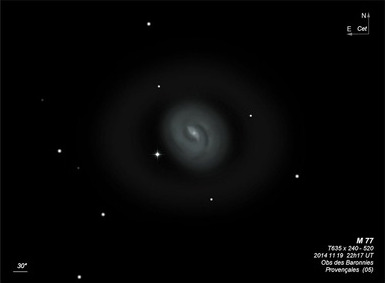
Pierre M?chain discovered M77 = NGC 1068 = h262 on 29 Oct 1780. William Herschel described M77 as "Very bright; an irregular extended nucleus with milky chevelure, 3 or 4' long, near 3' broad."
Lord Rosse's assistant Johnstone Stoney recorded M77 on 22 Dec 1848 as "a blue spiral?" and it was included in the list of "Spiral or curvilinear" object in Rosse's 1850 PT paper. Observing assistant Bindon Stoney made a sketch on 24 Nov 1851 (the description reads "The central part is, I am nearly sure, spiral") shown on plate XXV, figure 6 in LdR's 1861 paper (also Plate 1, Figure 4 in the 1880 publication). William Lassell's 1863 sketch, made using 760x with his 48-inch from Malta, shows a tight spiral emanating from a bright stellar nucleus and wrapping a full 360?.
Isaac Roberts' photograph in 1892 revealed considerable structure in the central region with a "dense composite nucleus, bounded by a broad nebulous ring, which is studded with strong condensations.."
200/250mm - 8" (11/28/81): bright, intense core, faint halo.
400/500mm - 17.5" (11/14/87): very bright, moderately large, sharp concentration with an unusually bright core, almost stellar nucleus, diffuse slightly elongated halo. Appears mottled at high power and a hint of inner arm structure. A mag 11 star is 1.3' ESE of the center. This is a Seyfert 2 galaxy and brightest in a group with NGC 1055 and 1073..
900/1200mm - 48" (10/26/11): at 375x; the view through Lowrey's 48-inch was remarkable. Spiral arm structure was easily visible with two main arms in the central halo and a bright inner arm around the nucleus and core. The bright inner arm attaches at the east side of the intense core, wraps tightly clockwise around the north side of the core and heads south on the west side of the core. There were two main arms in the central halo forming an elongated "S" pattern. A long spiral arm is attached near the east side of the core and wraps clockwise outside the inner arm described above. It continues around to the west side and heads south, ending near a compact HII knot ([EKS96] 19 from Evans et al 1996 "Atlas of H II Regions in Nearby Seyfert Galaxies"). A second long spiral arm is attached on the southwest side of the core and wraps clockwise to the east side of the core, passing inside of a 10" HII knot [EKS96] 79/80]. The arm rotates to the northern edge of the halo. Besides these main arms, several fainter sections of additional arms are tightly wrapped in the central halo. The main central region of the galaxy is encased in a very large, low surface brightness outer halo, extendng ~6'x5' WSW-ENE. NGC 1055, part of the M77 group, lies 30' NNE.
Notes by Steve Gottlieb